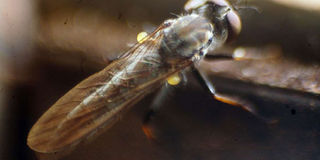Push to declare Kenya free from sleeping sickness

A tsetse fly which transmits sleeping sickness. FILE PHOTO | NMG
What you need to know:
- Earlier this year, the Health ministry sounded an alarm over the rising burden of NTDs in the country. Kenya has reported 16 out of the 20 listed NTDs worldwide.
- The latest data revealed that 25 million still people suffer from the diseases despite efforts to have them eliminated.
The government is upbeat that the World Health Organization (WHO) will remove Kenya from the list of countries burdened by Trypanosomiasis, commonly known as sleeping sickness.
This follows a continuous drop in the number of persons diagnosed with the Neglected Tropical Disease (NTDs).
Speaking in Kisumu last week, Dr Wyclife Omondi, who heads the Vector-borne and NTDs department at the Ministry of Health, said sleeping sickness is no longer a public health concern since the last active case was reported in 2009.
Already, the Health ministry is working on a dossier, a document developed to seek eradication of a specific disease, in order to justify the request.
“Today we are here to review the dossier before it is presented to WHO,” said Dr Omondi.
In order to be declared free from the disease, WHO requires endemic countries to submit documentation once they attain less than one per 10,000 members reported cases.
The document should provide evidence and statistics supporting a drop in the infections.
Dr Omondi said over the last five years, Kenya has been reporting less than one case per 10,000 people.
He revealed that there has been a decline in the cases reported in the six burdened counties - Siaya, Busia, Migori, Bungoma , Homa Bay and Narok in the past five years.
According to Dr Omondi, the cases have reduced due to effective control measures such as spraying of tsetse flies and provision of effective treatment to the infected persons.
“We have seen a decline in the vector population, which translates to fewer bites and transmission.
“Since the 1990’s, we have been reporting fewer cases. The last case in 2009 was of a Germany and Belgium nationals who had travelled to Kenya via Tanzania but tested positive after arriving in their countries,” said Dr Omondi.
Sleeping sickness has been a public health concern in Kenya since the 1940s.
The disease is transmitted to humans through bites by tsetse flies. It is characterised by fever, headaches, itching and joint pains.
Vector-borne and NTDS Coordinator Charles Odiwuor said continued screening in the six counties had proven the drop in numbers.
“Even with the drop, we will still be screening the residents in the six counties just in case of resurgence,” said Mr Odiwuor.
Earlier this year, the ministry sounded an alarm over the rising burden of NTDs in the country. Kenya has reported 16 out of the 20 listed NTDs worldwide.
The latest data revealed that 25 million still people suffer from the diseases despite efforts to have them eliminated.
According to Dr Omondi, the country is working to eliminate trypanosomiasis, river blindness and elephantiasis by 2027.





